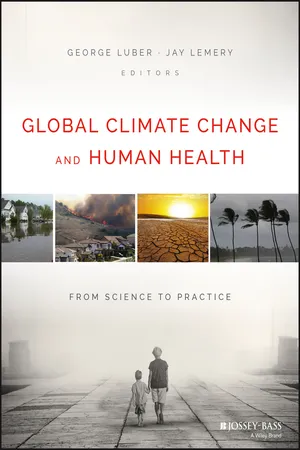
- English
- ePUB (mobile friendly)
- Available on iOS & Android
About This Book
Learn the foundations of climate science and human health
Global Climate Change and Human Health examines the environmental crisis from a public health and clinical health perspective, giving students and clinicians the information they need to prepare for the future of health care. Edited by George Luber, associate director for climate change at the Centers for Disease Control and Prevention, and Jay Lemery, associate professor at the University of Colorado School of Medicine and section chief of Wilderness and Environmental Medicine in the Department of Emergency Medicine, and including chapters written by luminaries in the field, this landmark book provides a comprehensive introduction to climate change and health. Students will learn about climate changes direct effect on health, including extreme weather events, altered and degraded ecosystems, and threats to human security and welfare. Discussions on mitigation and adaptation strategies, including disease surveillance, communications, and greening health care, as well as a primer on the core concepts of climate change science are presented. Each chapter has a specific section on the clinical correlations of the impact of climate change on health. Informative illustrations depict increasing aeroallergens, shifting vector habitats, emergent risks, and more. Visual teaching materials broken down by chapter (including PowerPoint lecture slides) are available for instructors.
This book shows how human health will be —and already has been — affected and how health care practitioners need to start preparing.
- Understand the science behind climate change and climate variability
- Learn how the availability of food and clean water will affect public health
- Consider the diseases that will surge as vector populations swell
- Discover mitigation strategies targeted toward the health care community
- Understanding how climate change affects human rights and how international institutions are responding
Increased temperatures bring algal blooms that threaten clean water. Degraded air quality brings allergies, asthma, and respiratory diseases. Ground pollutants lower the nutritional value of food crops. It's clear that climate change is very much a public health concern, and Global Climate Change and Human Health helps those preparing to be on the front lines of health care.
Frequently asked questions
Information
Part 1
Our Changing Planet: Emergent Risks for Human Health
Chapter 1
Primer on Climate Science
Key Concepts
- There is a strong consensus among climate scientists that global temperatures are increasing as a result of human activities.
- Weather, natural climate variability, and long-term climate change are distinct phenomena.
- The Earth is in an energy balance, which means that the amount of energy that enters the Earth's atmosphere is equal to the amount of energy that leaves the atmosphere.
- Three primary factors affect the Earth's energy balance: variability of solar intensity, reflectivity of the Earth's surface or atmosphere, and concentration of greenhouse gases.
- Natural solar radiation cycles affect the amount of solar energy reaching the Earth's surface, but they cannot account for the average global temperature increases we are experiencing.
- The greenhouse effect is a natural process that traps energy in the Earth' s system, causing average global temperatures to be warmer than they would be otherwise.
- Human activities have increased the concentration of greenhouse gases in the atmosphere, which have augmented the greenhouse effect and increased average global temperatures.
- Direct and indirect observations indicate with certainty that the global climate is changing.
- Average global temperatures have increased by approximately 0.85°C since 1880.
- In addition to increasing temperatures, observations over the past century have indicated that snow and sea ice cover is decreasing, the average global sea level is rising, and precipitation patterns are changing.
- Climate models make projections of future climate change.
- Climate models strongly suggest that the increasing global temperatures and climate change in the past century are due to anthropogenic emissions of greenhouse gases.
- Average global temperatures are expected to increase between approximately 0.8°C to 4.9°C by the end of this century.
- Temperatures will increase most over land and high-latitude regions.
- There will likely be an increase in extreme heat events associated with climate change.
- Most areas will see an increase in the amount of precipitation, and rainfall events may become more intense.
Scientific Consensus
Weather, Climate Variability, Climate Change, and Scientific Theory
Table of contents
- Cover
- Title Page
- Copyright
- Dedication
- Introduction
- Acknowledgments
- The Editors
- The Contributors
- Part 1: Our Changing Planet: Emergent Risks for Human Health
- Part 2: The Health Consequences of Climate Change
- Part 3: The Public Health Approach to Climate Change
- Part 4: Taking Action: Adaptation, Mitigation, and Governance
- Index
- End User License Agreement